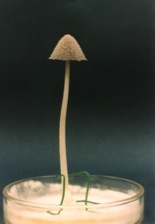
genome size
The genome size is 37.5 Mb.
Chromosomes
The genome is separated into 13 chromosomes.
Life cycle
The life cycle is completed within two weeks. The compatible monokaryons produce dikaryon, which form an elaborate multicellular fruit body, as shown in a left picture.
haploid fruiting strains
Haploid fruiting strains are available to isolate recessive mutations affecting dikaryotic phenotypes, such as fruit body development and dikaryosis.
Transformation
The monokaryotic hyphae produce copious oidia. The oidium is a single cell with a haploid nucleus. The oidia are useful for preparation of protoplasts for transformation. Transformation of the protoplasts obtained from oidia is performed by the PEG-Ca2+ method (Binninger et al. 1987).
BAC library
Transformable BAC clones are available, which carry the Coprinus trp1 gene as a selectable marker(Muraguchi et al. 2005).
Genome project
The genome project of this fungus was done by the Broad Institute, using Okayama-7 strain. We constructed a BAC library using Okayama-7 strain and assigned the BAC clones on the published genome sequences.

Coprinus cinereus (Coprinopsis cinerea)
Coprinus Community

Takashi Kamada, Okayama University, Japan
Lorna A. Casselton, University of Oxford, UK
Miriam Zolan, University of Indiana, Bloomington, USA
Patricia J. Pukkila, University of North Carolina, USA
David Moore, University of Manchester, UK
Ursel Kues, Georg-August University of Goetingen, Germany
Kazuo Shishido, Tokyo Institute of Technology, Japan
Kengo Sakaguchi, Science University of Tokyo, Japan
Jason E. Stajich, University of California Riverside, USA
Link







